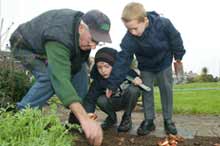How Genetic Engineering Has Created Large Varieties Of Apple Trees

As technology advances, more and more options are opened up. Suddenly, there are new types of electronic music, new ways of reading books, new ways to communicate and yes, new types of apple trees to buy!
Because of genetic engineering and importing capabilities, we have worked past the minimal kinds of apple trees, and advanced to many different types of flavors, colors, and apples. Here are five well-loved varieties of apples open to consideration for you apple tree.
Brae Burn
First becoming popular in the 1940's, the popularity of Brae Burn apples has spread from its original location of New Zealand, to becoming the best-selling apple in Germany. Beyond that, it has been greatly loved in the United States since the 1980's, recognized as one of the best-loved apples in the world. Perfect for slow eaters, Brae Burn apples generally don't brown very quickly after being cut. Distinguished its sweet, but slight tart taste, you can recognize this apple by its varying color of mostly red, to gold with red streaks. They become ripe around October or November.
Red Delicious
Red and delicious, this apple would not be hated for false advertising. Red Delicious apples are tall, large, and heart-shaped on the outside, and contain a crisp, juicy, sweet interior. First introduced to Peru, Iowa in 1874, these apples are now grown and loved all across the country. These apples are great to put in salads. They become ripe in mid to late September. They are usually best when they are fresh off the tree.
Golden Delicious
Designed much like the Red Delicious apple, the insides are crisp, juicy, and sweet, and are contained by a large, heart-shaped exterior. They make great accomplices to those who love to cook, the Golden Delicious keeps their taste and shape even when cooked or baked! Handle carefully though, the Golden Delicious bruises somewhat easy, however will last a long time if handles gently.
Fuji Apple
Distinguished by its yellow-green skin with red streaks, the Fuji apple has been enjoyed in 1962, starting in Japan. The insides are crunchy, flavorful, and sweet. While the trees can tolerate poor soil conditions, the fruit tends to reflect the soil quality. Fuji apples are often used for cooking, and taste best when they are fresh.
Gala Apples
Straight from New Zealand, they are considered one of the best-tasting apples you can grow (when fresh). They grow quickly, and offer much fruit. The Gala apple is medium sized, with yellow skin (with a hint of red). The insides are juicy, crisp and contain a wonderful scent. Because the Fuji is considered a better option, they are generally not used for cooking.
There are many different types of apple trees to consider. With enough research, you can find one best suited to your time, climate, and taste.
Article Source: http://www.article-exposure.com
Gregg Hall is an author living in Navarre Florida. Find more about this as well as www.shopforfruitbaskets.com">Shop For Fruit Baskets at www.shopforfruitbaskets.com







